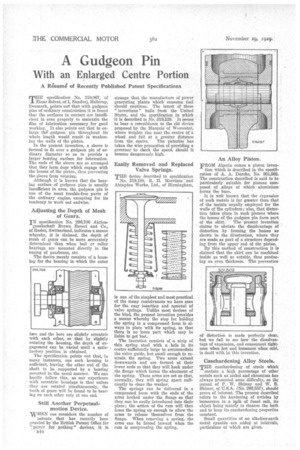A Gudgeon Pin
Page 78

If you've noticed an error in this article please click here to report it so we can fix it.
With an Enlarged Centre Portion
A Resume of Recently Published Patent Specifications
T'specification No. 319,067, of Einar Solver, of 1, Sundvej, He-Hemp, Denmark, points out that with gudgeon pins of ordinary construction it is found that the surfaces in contact are insufficient in area properly to maintain the film of lubrication necessary for good working. It also points out that to enlarge the gudgeon pin throughout its whole length would result in weakening the walls of the piston.
In the present invention, a sleeve is formed to fit over a gudgeon pin of ordinary diameter so as to provide a larger bearing surface for lubrication. The ends of the sleeve are so arranged that they form dogs which engage with the bosses of the piston, thus preventing the sleeve from rotating. Although it is known that the bearing surface of gudgeon pins is usually insufficient in area, the gudgeon pin is one of the most trouble-free parts of the ordinary engine, excepting for its tendency to work out endwise.
Adjusting the Depth of Mesh of Gears.
IN specification No. 296,706 Aktien gesellschaft Brown Boveri and Co., nf Baden, Switzerland, indicates a means whereby, it is claimed, the depth of mesh of gears can be more accurately determined than when ball or roller bearings are mounted directly in the casing of gearboxes, etc. The device merely consists of a housing for the bearing in which the outer
face and the bore are slightly eccentric with each other, so that by slightly -rotating the .housing, the depth of engagement can be varied until a satisfactory position is obtained.
The specification points out that ie many instances, one such housing is sufficient, leaving the other end of the shaft to be supported by a bearing mounted in the usual manner. We can hardly follow this, as our experience with eccentric housings is that unless they are rotated simultaneously, the teeth of gears will be found to be bearing on each other only at one end.
Still Another Perpetualmotion Device.
WHEN one considers the number of patents that has recently been granted by the British Patent Office for '.t.PoWer for nothing" devices, it is E4-1 strange that the manufacture of power generating plants which' consume fuel should continue. The latest of these "inventions" hails froth the United States, and the specification in which it is described is No. 319,129. It seems to bear a yeSenablance to the old device, proposed by the Marquis of Worcester, where weights rise near the centre of_ a wheel and fall at a greater distance from the centre. The patentee has taken the wise precaution of-providing a governor to check the speed, Should it became dangerously high.
'13 one of the simplest and most practical of the many contrivances we have seen for the easy insertion and removal of valve springs. Unlike most devices of the kind, the present invention provides a means whereby the stop for holding the spring in a compressed form is always in place with its spring, so that there is no loose part which may be liable to get lost.
The invention consists of a strip of thin spring steel with a hole in its centre sufficiently large to accommodate the valve guide, but small enough to restrain the spring. Two arms extend downwards and are formed at their lower ends so that they will hook under the flange which forms the abutment of the spring. These arms are set so that, normally, they will spring apart sufficiently to clear the washer.
The springs can be delivered in a compressed form with the ends of the arms hooked under the flange so that they can be easily introduced into their place ; the action of the cam will then force the spring up enough to allow the arms to release themselves from the flange. When removing a spring, the arms can be forced inward when the cam is compressing the spring. FROM Algeria conies a piston inven
tion which is described in the specification of A. A. Darche, No. 301.502. The construction described is said to be particularly suitable for pistons composed of alloys of which aluminium forms the base.
It is well known that the expansion of such metals is far greater than that of the metals usually employed for the walls of the cylinders ; also, that distortion takes place in such pistons where the bosses of the gudgeon pin form part
of the skirt. The Present invention claims to obviate the disadvantage of distortion by forming the bosses as shown in the illustration, where they are made as part of a structure depending from the upper end of the piston. By this method of construction it is claimed that the skirt can be machined inside as well as outside, thus producing an even thickness. The prevention of distortion is made perfectly clear, but we fail to see how the disadvantage of expansion, and consequent tightness when hot and looseness when cold, is dealt with in this invention.
Casehardening Alloy Steels. THE casehardening of steels which contain a high percentage of other metals such as nickel and chromium has always presented some difficulty, so the patent of P. W. Skinner and W. B. Shimer, of U.S.A. (No. 292,557), should prove of interest. The process described refers to the hardening of articles by immersion in a bath of fused salt, its object being mainly to cleanse the bath and to keep its casehardening, properties constant. -Small quantities of an alkaline-earth metal cyanide are added at intervals, particulars of which are given.




















































































































